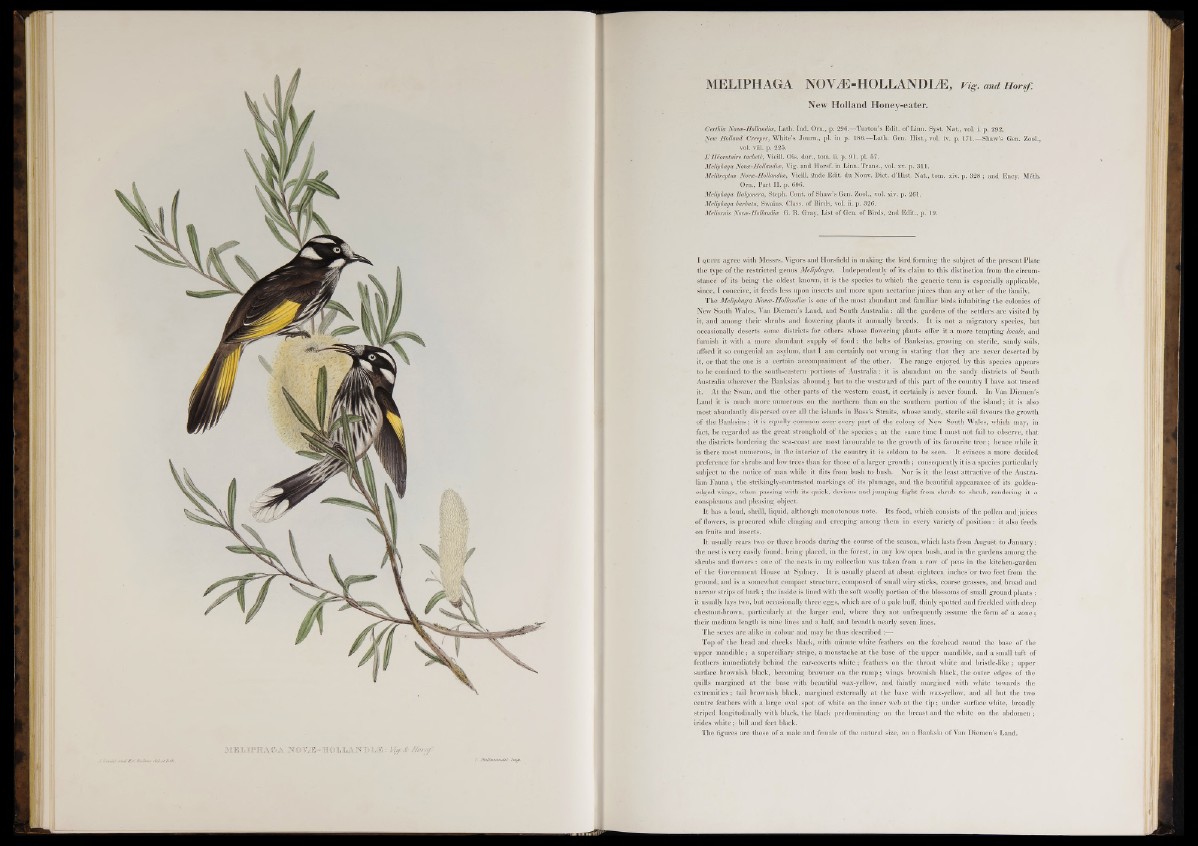
MELIPHAGA NOVÆ-HOLLANDIÆ, n g . and Horsf.
New Holland Honey-eater.
Certhia Novoe-Hollandioe, Lath. Ind. Ora., p. 296^—Turton’s Edit, of Linn. Syst. Nat., vol. i. p. 292.
New Holland Creeper, White’s joum., pi. in p. 186.—Lath. Gen. Hist., vol. iv. p. 171.—Shaw’s Gen. Zool.,
vol. viii. p. 225.
V Héorotaire tacheté, Vieill. Ois. dor., tom. ii. p. 91. pi. 57.
Meliphaga Novoe-Hollandioe, Vig. and Horsf. in Linn. Trans., vol. xv. p. 311.
Melitreptus Novoe-Hollandioe, Vieill. 2nde Edit, du Nouv. Diet. d’Hist. Nat., tom. xiv. p. 328 ; and Ency. Méth.
Ora., Part II. p. 606.
Meliphaga Balgonera, Steph. Cont. of Shaw’s Gen. Zool., vol. xiv. p. 261.
Meliphaga barbata, Swains. Class, of Birds, vol. ii. p. 326.
Meliomis Novoe-Hollandioe G. R. Gray, List of Gen. of Birds, 2nd Edit., p. 19.
I q u it e agree with Messrs. Vigors and Horsfield in making the bird forming the subject of the present Plate
the type of the restricted genus Meliphaga. Independently of its claim to this distinction from the circumstance'
of its being the oIdestt known, it is the species to which the generic term is especially applicable,
since, I conceive, it feeds less upon insects and more upon nectarine juices than any other o f the family.
The Meliphaga Novee-Hollandice is one of the most abundant and familiar birds inhabiting the colonies of
New South Wales, Van Diemen’s Land, and South Australia: all the gardens of the settlers are visited by
it, and among their shrubs and flowering plants it annually breeds. It is not a migratory species, but
occasionally deserts some districts for others whose flowering plants offer it a more tempting locale, and
furnish it with a more abundant supply o f food: the belts o f Banksias, growing on sterile, sandy soils,
afford it so congenial an asylum, that I am certainly not wrong in stating that they are never deserted by
it, or that the one is a certain accompaniment of the other. The range enjoyed by this ‘species appears
to be confined to the south-eastern portions of Australia: it is abundant on the sandy districts o f South
Australia wherever the Banksias abound; but to the westward of this part of the country I have not traced
it. At the Swan, and the other parts of the western coast, it certainly is never found. In Van Diemen’s
Land it is much more numerous on the northern than on the southern portion of the island; it is also
most abundantly dispersed over all the islands in Bass’s Straits, whose sandy, sterile soil favours the growth
of the Banksias; it is equally common over every part o f the colony o f New South Wales, which may, in
fact, be regarded as the great stronghold o f the species; at the same time I must not fail to observe, that
the districts bordering the sea-coast are most favourable to the growth of its favourite tree; hence while it
is there most numerous, in the interior of the country it is seldom to be seen. It evinces a more decided
preference for shrubs and low trees than for those o f a larger growth; consequently it is a species particularly
subject to the notice of man while it flits from bush to bush. Nor is it the least attractive of the Australian
Fauna; the strikingly-contrasted markings of its plumage, and the beautiful appearance of its golden-
edged wings, when passing with its quick, devious and jumping flight from shrub to shrub, rendering it a
conspicuous and pleasing object.
It has a loud, shrill, liquid, although monotonous note. Its food, which consists of the pollen and juices
of flowers, is procured while clinging and creeping among them in every variety of position : it also feeds
on fruits and insects.
It usually rears two or three broods during the course of the season, which lasts from August to January:
the nest is very easily found, being placed, in the forest, in any low open bush, and in the gardens among the
shrubs and flowers: one of the nests in my collection was taken from a row of peas in the kitchen-garden
of the Government House at Sydney. It is usually placed at about eighteen inches'or two feet from the
ground, and is a somewhat compact structure, composed o f small wiry sticks, coarse grasses, and broad and
narrow strips of bark; the inside is lined with the soft woolly portion of the blossoms of small ground plants :
it usually lays two, but occasionally three eggs, which are of a pale buff, thinly spotted aud freckled with deep
chestnut-brown, particularly at the larger end, where they not unfrequently assume the form o f a zone;
their medium length is nine lines and a half, and breadth nearly seven lines.
The sexes are alike in colour and may be thus described:—
Top of the head and cheeks black, with minute white feathers on the forehead round the base o f the
upper mandible; a superciliary stripe, a moustache at the base of the upper mandible, and a small tuft of
feathers immediately behind the ear-coverts white; feathers on the throat white and bristle-like; upper
surface brownish black, becoming browner on the rump; wings brownish black, the outer edges o f the
quills margined at the base with beautiful wax-yellow, and faintly margined with white towards the
extremities; tail brownish black, margined externally at the base with wax-yellow, and all but the two
centre feathers with a large oval spot of white on the inner web at the tip ; under surface white, broadly
striped longitudinally with black, the black predominating on the breast and the white on the abdomen ;
irides white;-bill and feet black.
The figures are those of a male and female of the natural size, on a Banksia of Van Diemen’s Land.